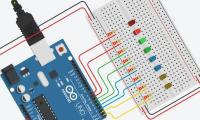SoftwareSerial
- SoftwareSerial()
- available()
- begin()
- isListening()
- overflow()
- peek()
- read()
- print()
- println()
- listen()
- write()
专题
SoftwareSerial.print()
Prints data to the transmit pin of the SoftwareSerial object. Works the same as the Serial.print() function.
Syntax
mySerial.print(val)Parameters
- val: the value to print.
Returns
The number of bytes written (reading this number is optional).
Example
#include <SoftwareSerial.h>
// Set up a new SoftwareSerial object with RX in digital pin 10 and TX in digital pin 11
SoftwareSerial mySerial(10, 11);
int analogValue;
void setup() {
// Set the baud rate for the SerialSoftware object
mySerial.begin(9600);
}
void loop() {
// Read the analog value on pin A0
analogValue = analogRead(A0);
// Print analogValue in the Serial Monitor in many formats:
mySerial.print(analogValue); // Print as an ASCII-encoded decimal
mySerial.print("\t"); // Print a tab character
mySerial.print(analogValue, DEC); // Print as an ASCII-encoded decimal
mySerial.print("\t"); // Print a tab character
mySerial.print(analogValue, HEX); // Print as an ASCII-encoded hexadecimal
mySerial.print("\t"); // Print a tab character
mySerial.print(analogValue, OCT); // Print as an ASCII-encoded octal
mySerial.print("\t"); // Print a tab character
mySerial.print(analogValue, BIN); // Print as an ASCII-encoded binary
mySerial.print("\t"); // Print a tab character
mySerial.print(analogValue/4, BYTE); // Print as a raw byte value (divide the
// value in 4 because analogRead() function returns numbers
// from 0 to 1023, but a byte can only hold values up to 255)
mySerial.print("\t"); // Print a tab character
mySerial.println(); // Print a line feed character
// Pause for 10 milliseconds before the next reading
delay(10);
} Arduino
Arduino

